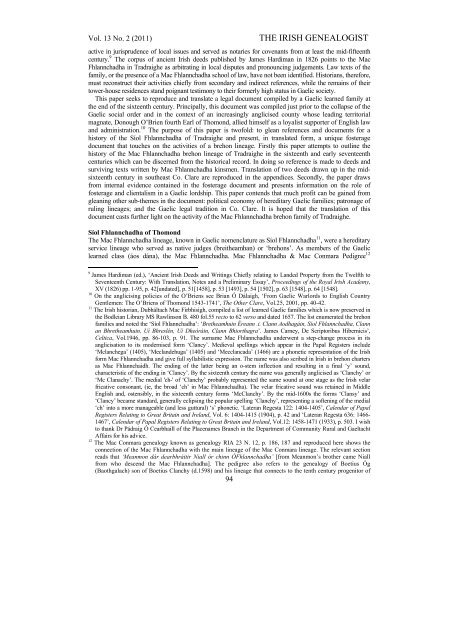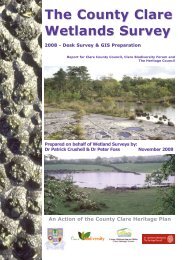A Mac Fhlannchadha Fosterage Document, c.1580 - Clare County ...
A Mac Fhlannchadha Fosterage Document, c.1580 - Clare County ...
A Mac Fhlannchadha Fosterage Document, c.1580 - Clare County ...
You also want an ePaper? Increase the reach of your titles
YUMPU automatically turns print PDFs into web optimized ePapers that Google loves.
Vol. 13 No. 2 (2011)THE IRISH GENEALOGISTactive in jurisprudence of local issues and served as notaries for covenants from at least the mid-fifteenthcentury. 9 The corpus of ancient Irish deeds published by James Hardiman in 1826 points to the <strong>Mac</strong><strong>Fhlannchadha</strong> in Tradraighe as arbitrating in local disputes and pronouncing judgements. Law texts of thefamily, or the presence of a <strong>Mac</strong> <strong>Fhlannchadha</strong> school of law, have not been identified. Historians, therefore,must reconstruct their activities chiefly from secondary and indirect references, while the remains of theirtower-house residences stand poignant testimony to their formerly high status in Gaelic society.This paper seeks to reproduce and translate a legal document compiled by a Gaelic learned family atthe end of the sixteenth century. Principally, this document was compiled just prior to the collapse of theGaelic social order and in the context of an increasingly anglicised county whose leading territorialmagnate, Donough O’Brien fourth Earl of Thomond, allied himself as a loyalist supporter of English lawand administration. 10 The purpose of this paper is twofold: to glean references and documents for ahistory of the Síol <strong>Fhlannchadha</strong> of Tradraighe and present, in translated form, a unique fosteragedocument that touches on the activities of a brehon lineage. Firstly this paper attempts to outline thehistory of the <strong>Mac</strong> <strong>Fhlannchadha</strong> brehon lineage of Tradraighe in the sixteenth and early seventeenthcenturies which can be discerned from the historical record. In doing so reference is made to deeds andsurviving texts written by <strong>Mac</strong> <strong>Fhlannchadha</strong> kinsmen. Translation of two deeds drawn up in the midsixteenthcentury in southeast Co. <strong>Clare</strong> are reproduced in the appendices. Secondly, the paper drawsfrom internal evidence contained in the fosterage document and presents information on the role offosterage and clientalism in a Gaelic lordship. This paper contends that much profit can be gained fromgleaning other sub-themes in the document: political economy of hereditary Gaelic families; patronage ofruling lineages; and the Gaelic legal tradition in Co. <strong>Clare</strong>. It is hoped that the translation of thisdocument casts further light on the activity of the <strong>Mac</strong> <strong>Fhlannchadha</strong> brehon family of Tradraighe.Síol <strong>Fhlannchadha</strong> of ThomondThe <strong>Mac</strong> <strong>Fhlannchadha</strong> lineage, known in Gaelic nomenclature as Síol <strong>Fhlannchadha</strong> 11 , were a hereditaryservice lineage who served as native judges (breitheamhan) or ‘brehons’. As members of the Gaeliclearned class (áos dána), the <strong>Mac</strong> <strong>Fhlannchadha</strong>. <strong>Mac</strong> <strong>Fhlannchadha</strong> & <strong>Mac</strong> Conmara Pedigree 129James Hardiman (ed.), ‘Ancient Irish Deeds and Writings Chiefly relating to Landed Property from the Twelfth toSeventeenth Century: With Translation, Notes and a Preliminary Essay’, Proceedings of the Royal Irish Academy,XV (1826) pp. 1-95, p. 42[undated], p. 51[1458], p. 53 [1493], p. 54 [1502], p. 63 [1548], p. 64 [1548].10 On the anglicising policies of the O’Briens see Brian Ó Dálaigh, ‘From Gaelic Warlords to English CountryGentlemen: The O’Briens of Thomond 1543-1741’, The Other <strong>Clare</strong>, Vol.25, 2001, pp. 40-42.11 The Irish historian, Dubháltach <strong>Mac</strong> Firbhisigh, compiled a list of learned Gaelic families which is now preserved inthe Bodleian Library MS Rawlinson B. 480 fol.55 recto to 62 verso and dated 1657. The list enumerated the brehonfamilies and noted the ‘Síol <strong>Fhlannchadha</strong>’: ‘Bretheamhuin Éreann .i. Clann Aodhagáin, Síol <strong>Fhlannchadha</strong>, Clannan Bhretheamhuin, Uí Bhreslén, Uí Dheóráin, Clann Bhiorthagra’. James Carney, De Scriptoribus Hibernicis’,Celtica, Vol.1946, pp. 86-103, p. 91. The surname <strong>Mac</strong> <strong>Fhlannchadha</strong> underwent a step-change process in itsanglicisation to its modernised form ‘Clancy’. Medieval spellings which appear in the Papal Registers include‘Mclanchega’ (1405), ‘Meclandehuga’ (1405) and ‘Mecclancada’ (1466) are a phonetic representation of the Irishform <strong>Mac</strong> <strong>Fhlannchadha</strong> and give full syllabilistic expression. The name was also scribed in Irish in brehon chartersas <strong>Mac</strong> Fhlannchaidh. The ending of the latter being an o-stem inflection and resulting in a final ‘y’ sound,characteristic of the ending in ‘Clancy’. By the sixteenth century the name was generally anglicised as ‘Clanchy’ or‘Mc Clanachy’. The medial 'ch-' of ‘Clanchy’ probably represented the same sound at one stage as the Irish velarfricative consonant, (ie, the broad ‘ch’ in <strong>Mac</strong> <strong>Fhlannchadha</strong>). The velar fricative sound was retained in MiddleEnglish and, ostensibly, in the sixteenth century forms ‘McClanchy’. By the mid-1600s the forms ‘Clansy’ and‘Clancy’ became standard, generally eclipsing the popular spelling ‘Clanchy’, representing a softening of the medial‘ch’ into a more manageable (and less guttural) ‘s’ phonetic. ‘Lateran Regesta 122: 1404-1405’, Calendar of PapalRegisters Relating to Great Britain and Ireland, Vol. 6: 1404-1415 (1904), p. 42 and ‘Lateran Regesta 636: 1466-1467’, Calendar of Papal Registers Relating to Great Britain and Ireland, Vol.12: 1458-1471 (1933), p. 503. I wishto thank Dr Pádraig Ó Cearbhaill of the Placenames Branch in the Department of Community Rural and GaeltachtAffairs for his advice.12 The <strong>Mac</strong> Conmara genealogy known as genealogy RIA 23 N. 12, p. 186, 187 and reproduced here shows theconnection of the <strong>Mac</strong> <strong>Fhlannchadha</strong> with the main lineage of the <strong>Mac</strong> Conmara lineage. The relevant sectionreads that ‘Meanmon dár dearbhráitir Niall ór chinn Ó<strong>Fhlannchadha</strong>’ [from Meanmon’s brother came Niallfrom who descend the <strong>Mac</strong> <strong>Fhlannchadha</strong>]. The pedigree also refers to the genealogy of Boetius Óg(Baothgalach) son of Boetius Clanchy (d.1598) and his lineage that connects to the tenth century progenitor of94
















